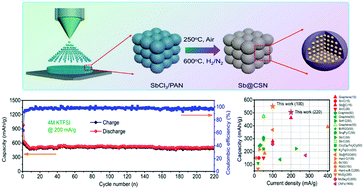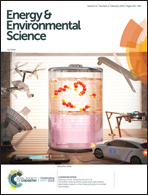Extremely stable antimony–carbon composite anodes for potassium-ion batteries†
Abstract
Potassium-ion batteries (PIBs) have been considered as promising alternatives to lithium-ion batteries due to potassium's high natural abundance of 2.09 wt% (vs. 0.0017 wt% for Li) and K/K+ having a low redox potential of −2.93 V (vs. −2.71 V for Na/Na+). However, PIB electrodes still suffer huge challenges due to the large K-ion radius and slow reaction dynamics. Herein, we report a high-capacity Sb@CSN composite anode with Sb nanoparticles uniformly encapsulated by a carbon sphere network (CSN) for PIBs. First-principles computations and electrochemical characterization confirm a reversible sequential phase transformation of KSb2, KSb, K5Sb4, and K3Sb during the potassiation/depotassiation process. In a concentrated 4 M KTFSI/EC + DEC electrolyte, the Sb@CSN anode delivers a high reversible capacity of 551 mA h g−1 at 100 mA g−1 after 100 cycles with an extremely slow capacity decay of only 0.06% per cycle from the 10th to 100th cycle; when at a high current density of 200 mA g−1, the Sb@CSN anode still maintains a capacity of 504 mA h g−1 after 220 cycles. The Sb@CSN anodes demonstrate one of the best electrochemical performances for all K-ion battery anodes reported to date. The exceptional performance of Sb@CSN should be attributed to the efficient encapsulation of small Sb nanoparticles in the conductive carbon network as well as the formation of a robust KF-rich SEI layer on the Sb@CSN anode in the concentrated 4 M KTFSI/EC + DEC electrolyte.

- This article is part of the themed collection: 2019 Energy and Environmental Science HOT Articles


 Please wait while we load your content...
Please wait while we load your content...
